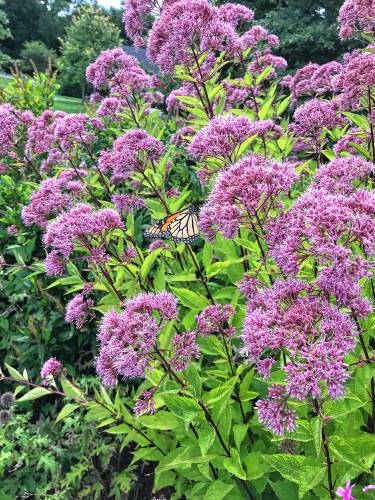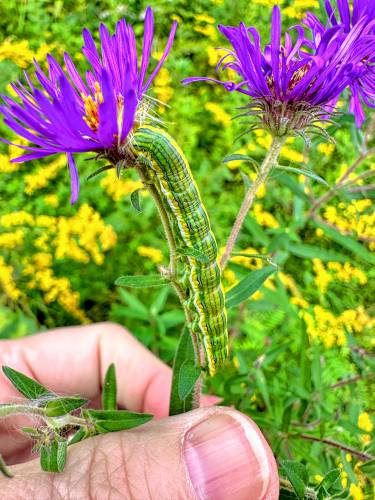Planting to support birds: Ecologist maps out a plan at Greening Greenfield’s Supporting Birds in Our Community series
| Published: 02-14-2025 11:27 AM |
A crowd recently gathered at the Second Congregational Church to hear ecologist and educator Dr. Martha Gach describe how to support birds by growing and tending plants. Gach delivered a sobering update: the number of birds worldwide has decreased by 30% since 1970; nearly 3 billion birds died unnaturally in that time span.
A retired Mass Audubon staffer, Gach said, “We don’t know all of the reasons for the demise of so many birds, but habitat loss and insecticides are likely primary causes, along with [construction] development and climate change.” People can help reverse the trend by maintaining landscapes to build diversity. Gach shares ideas for cultivating healthy habitat using locally-adapted trees, shrubs, flowers, and grasses that provide food, shelter, and nesting materials for birds.
Nancy Hazard introduced Gach’s program, the first in Greening Greenfield’s Supporting Birds in Our Community series. “Ten years ago, I planned to put in berry bushes to draw birds,” said Hazard. “Then I read Doug Tallamy’s book, ‘Bringing Nature Home,’ and learned that berry bushes aren’t enough! My yard was missing what birds need to raise their young: native plants, especially trees and shrubs, where birds find protein-rich caterpillars for their nestlings.”
Most birds fly, but not all; not all flying creatures are birds. (We’re looking at you, bats.) Birds sing, have wings, no teeth, and are the only creatures with feathers. They famously woo and court and – while they’re territorial – they don’t mind people witnessing their interactions. Many exhibit superb parenting traits, tirelessly feeding babies and keeping nests clean. Bird babies poop in a sac, which parents remove from the nest so predators can’t find the babies.
Some birds migrate, linking continents. “A yellow warbler flies from Cuba or Ecuador,” said Gach, “and goes back and forth (annually). It requires great endurance to make that journey. A bird weighing as little as five paper clips can fly non-stop for three days and nights.” Other feathered friends – like crows, titmice, black-capped chickadees and cardinals – remain local year-round. “All birds need safe spaces,” said Gach. “We welcome them by building habitats, which are ecosystems with food chains or food webs. Energy flows in an ecosystem: plants capture energy from the sun, and creatures eat the plants and resulting seeds.” Gach reminded listeners that birds have places on the food chain as both eaters and eaten. “A cardinal can become dinner for a fox, hawk, or owl,” she said. “If you put up birdfeeders, hawks may come to dine on other birds.”
Many birds eat insects, and some are opportunivores who eat insects, seeds and fruits. In strategizing habitat, think about birds’ preferences throughout the year. “Staghorn sumac isn’t their favorite,” said Gach, “but they’ll go for it in January because it’s better than nothing.” Is it okay to stock birdfeeders, or is it better for birds to eat from nature? Downsides of feeders include expense, and the risk of attracting rodents. “Feeders aren’t natural; they’re more like ice cream trucks,” said Gach, “but they make for great bird watching. My father had 11 feeders, one for every kind of bird.” She emphasized that feeders must be thoroughly cleaned every week or two with a mild bleach solution to prevent the spread of disease.
Gach said it’s best for birds to subsist on nature’s offerings, and that humans can help in this regard. Local plant varieties are optimal. Gach suggests native shrubs and trees like blueberry, spicebush, winterberry, ninebark, chokecherry, dogwoods, black gum, and tupelo. Many flowers help support bird life: blueflag iris, penstemon, bergamot, milkweed, boneset, and joe-pye weed. The list seems endless: ironweed, cardinal flower, asters, goldenrod, pearly everlasting, rudbekia, red columbine, spotted bee balm. Gach recommends an online resource called Native Plant Finder – you type in your zip code – as well information from the Native Plant Trust, and many books by Doug Tallamy.
Consider native groundcovers, too. How you plant is as important as what you plant: planning for varied heights and seasonal availability of food sources can make a big difference, as can what you do when plants go by. “If you leave seeds and stems,” said Gach, “you’ll see lots of tracks in winter.”
Article continues after...
Yesterday's Most Read Articles
Native plants have evolved in place. “They thrive in local soils, rainfall, weather, and climate,” said Gach. They also attract far more insects than non-native species. This is crucial, since insects are at the top of many birds’ menus. “(Non-native) Kousa dogwoods are often found with no insects, while a native flowering dogwood plant can be found with 117 different kinds of caterpillars!” Gach’s enthusiasm makes insects seem almost delicious: “Birds love fat, juicy caterpillars, katydids, and dragonflies. Baby birds love butterfly and moth larvae, which provide fluids, proteins, lipids, and fats.”
Gach emphasized that sometimes humans can do more by doing less: “Giving less space over to standard lawns means less mowing, less energy use and pollution, and less watering. Decreasing or eradicating the use of road salt would translate to better health for soils and plants.” Gach’s talk illustrated the oft-repeated maxim that we all belong to a web of life, and she left her audience with practical suggestions about how to honor that ethic.
Greening Greenfield’s next bird-related event is Monday, Feb. 24 at 6:30 p.m., when Greenfield resident and naturalist Pat Serrentino will explain how small actions can result in big outcomes in a program titled “Sharing Your Yard With Birds: What You Can Do to Keep them Healthy and Happy.”
Eveline MacDougall is the author of “Fiery Hope,” and an avid gardener, musician, artist and mom. To contact her: eveline@amandlachorus.org.








 Conway Historical Society to explore ‘forgotten Founding Father’ Joseph Hawley
Conway Historical Society to explore ‘forgotten Founding Father’ Joseph Hawley Fun Fest to showcase day of music in Turners Falls on May 10
Fun Fest to showcase day of music in Turners Falls on May 10 Northfield’s Trinitarian Congregational Church marks 200th year, looks to continue its ‘living legacy’
Northfield’s Trinitarian Congregational Church marks 200th year, looks to continue its ‘living legacy’ Speaking of Nature: Climbing out on a limb: The Hartford fern is not your typical fern
Speaking of Nature: Climbing out on a limb: The Hartford fern is not your typical fern
